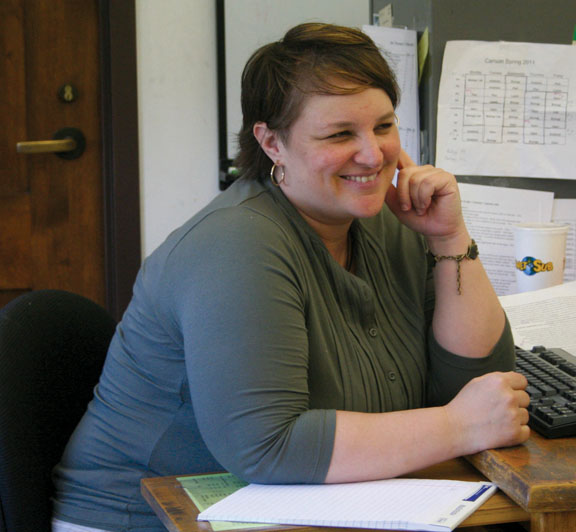Stepping into the third floor hallway of Donnelly Hall, STA science teacher Amy Carlson was immediately startled and surprised by the cheers, signs and abundant amount of food set up in the hallway. Carlson’s advisees, students and fellow teachers surrounded her. People came up and hugged Carlson, telling her how much they had missed her. A student Carlson had never met was there assuring Carlson of the community’s prayers. Sitting at the back table of her classroom talking to her substitute teacher, Mr. Chronister, Carlson looked overwhelmed but glad to be back at school.
Fellow STA science teacher, Mary Montag, planned this surprise party for Carlson on her return from surgery on her recently diagnosed brain tumor.
Living with It
When Carlson was diagnosed with her brain tumor, doctors told her that her tumor had been growing for two or three years. For that amount of time, Carlson was plagued with frequent migraines and ‘brain zaps” that affected her teaching and volleyball coaching. Throughout the year the headaches were so extreme that she couldn’t drive to work. Some days, Carlson found rides, other days she wouldn’t come to school. She also found herself switching lesson plans because of her vision. If her class had to do something with microscopes, Carlson would have to switch lesson plans to something that didn’t require fine eyesight.
“‘I got so used to feeling bad,” Carlson said. “I couldn’t even realize that I didn’t used to feel like this. It taught me to never take feeling good for granted.”
Carlson describes her “brain zaps” as very brief “jolts” like an electric shock across her brain.
Carlson had many days where she also felt flu-like symptoms, causing her to miss days of school. She also felt like she was losing her eyesight.
“It was extremely scary when I was losing my eyesight,” said Carlson. “I would go in and out and at times I could barely see my computer screen.”
Montag had become aware of Carlson’s symptoms.
‘She’d been having headaches and the symptoms were persisting and getting worse,’ Montag said. ‘We just wanted to know what we were dealing with.
Within the last four months, as Carlson felt her symptoms worsen, she began seeing numerous doctors, but according to Carlson, none could pinpoint the cause.
Then, when Carlson was at her eye doctor he noticed some confusing patterns. At times Carlson would have 20/20 vision and the next second she couldn’t see anything. The doctor then looked into Carlson’s eyes and noticed something pushing up against her optic nerve.
“He asked me if I would take an MRI,” Carlson said. “After the MRI, everyone was being very nice to me and offering me something to drink and I knew something was up.”
The eye doctor then told Carlson that he would be sending her to another doctor and requested that she call a friend or family member to accompany her. After waiting an hour for a friend to arrive, Carlson went in to meet the other doctor. He introduced himself, then told her she had a brain tumor.
Carlson was diagnosed with a baseball-sized Oligoastrocytom tumor on the right frontal lobe of her brain that she named “Tumzilla.” Oligoastrocytom is a slow growing tumor that can be controlled but not cured. According to the American Brain Tumor Association, headaches, like Carlson’s, are the most common symptoms for this type of tumor. According to ABTA, this part of the brain has to do with memory. This would explain Carlson’s ‘brain zaps’ that had been occurring frequently.
Carlson went in for her surgery on March 1. After eight hours of operating, the tumor had been removed.
“[The doctors] went in and shaved from ear to ear,” Carlson said. “Then they pulled back the skin there and then operated through a two-inch hole in my skull that they had created and then went through some brain matter before being able to remove the tumor.”
Amused, Carlson recounted a story about waking up from surgery, the heavy, painkilling medication caused her to text some co-workers at three in the morning saying, “No dain damage, I be at work on Monday.”
Although she will experience some setbacks, such as memory loss and focus issues, Carlson feels that so far, her recovery has been successful.
Carlson was out of the hospital after just two days and was so excited to be without the migraines that she didn’t want to rest. According to Carlson’s mother, Lorena, she had to tie Carlson to the couch to get her to rest.
“After the first few weeks I got my stamina back,” Carlson said while smiling. “I’m feeling great and that’s why I’m recovery so well. I feel so good without that tumor in my head.”
Carlson returned back to teaching full time on April 11, just six weeks after her surgery. However, she will be missing a few days for checkups and doctor’s appointments.
Sophomore biology student, Natalie Winterman is glad to see Carlson’s recovering so well.
“I was really worried when I first heard about [Carlson’s] tumor,” Winterman said. ‘I’m just glad to have her back in the classroom and feeling better.”
Helping Out
According to Carlson, the support she felt from the STA community was overwhelming.
“The community really reached out to me,” Carlson said. “Even students I had never met were really supportive and kind.”
According to Montag, who taught Carlson’s biology class while Carlson was gone, she and other faculty members did everything they could to make Carlson’s absence worry free.
“‘The whole idea was ‘How can we relieve stress from [Carlson]?”’ Montag said.”But also keeping the students moving forward and the advisory taken care of.”
Montag, as well as science teacher Renee Blake, who taught Carlson’s anatomy classes and Mrs. Kelly Drummond, who took care of Carlson’s advisory and substitute teachers, helped keep everything stress free for Carlson. Carlson attributes their help to her low anxiety levels while gone from school.
Montag was surprised and reassured by the support that she saw from everyone at STA.
‘There were so many cards,” Montag said. “Cards from individuals, cards from classes, cards from advisories and even a large thought box. It was truly incredible.”
Carlson not only received an outpouring of cards and kind messages, but also prayers.
“I really feel like the prayers helped with how speedy my recovery was,” Carlson said. “Prayer definitely makes a difference and an impact.”
Carlson is happy to be back and teaching again.
“[Ever since I came back], I have a constant smile and I’m back and able to teach without being blind and having a headache.”












Madison Sargent • May 12, 2011 at 10:01 am
I like the way you labeled the topics because it gave a step by step type of analysis, which reminded me of a doctors’office, so it all tied together nicely!